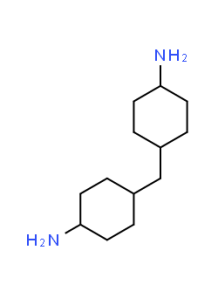4,4-Diaminodicyclohexyl Methane (HDMA)
- Product Code: 35151
commonly used as a curing agent in the production of polyurethane elastomers
- -
- -
- -
- -
- -
- -
- -
- -
- -
- -
- -
- -
- -
- -
- -
- -
- -
4,4'-Diaminodicyclohexyl methane (HDMA) is an organic compound with the chemical formula C13H26N2. It is a type of diamine, meaning it contains two amino (-NH2) groups. In this compound, two cyclohexyl rings are connected by a methane (-CH2-) bridge, and each cyclohexyl ring has an amino group attached at the 4th carbon position.
HDMA is commonly used as a curing agent in the production of polyurethane elastomers. When reacted with diisocyanates, such as toluene diisocyanate (TDI) or diphenylmethane diisocyanate (MDI), HDMA participates in the formation of urethane linkages, which are essential for cross-linking the polymer chains and curing the polyurethane material.
Polyurethane elastomers produced using HDMA as a curing agent exhibit excellent mechanical properties, including high tensile strength, tear resistance, and abrasion resistance. These elastomers find applications in various industries such as automotive, construction, footwear, and industrial manufacturing, where durable and flexible materials are required.
Additionally, HDMA is sometimes used in combination with other curing agents or additives to tailor the properties of the final polyurethane product according to specific application requirements.
Be the first to review this product :-)
Recommend Lab-Service
| Lab Service | Price |
|---|

commonly used as a curing agent in the production of polyurethane elastomers
4,4'-Diaminodicyclohexyl methane (HDMA) is an organic compound with the chemical formula C13H26N2. It is a type of diamine, meaning it contains two amino (-NH2) groups. In this compound, two cyclohexyl rings are connected by a methane (-CH2-) bridge, and each cyclohexyl ring has an amino group attached at the 4th carbon position.
HDMA is commonly used as a curing agent in the production of polyurethane elastomers. When reacted with diisocyanates, such as toluene diisocyanate (TDI) or diphenylmethane diisocyanate (MDI), HDMA participates in the formation of urethane linkages, which are essential for cross-linking the polymer chains and curing the polyurethane material.
Polyurethane elastomers produced using HDMA as a curing agent exhibit excellent mechanical properties, including high tensile strength, tear resistance, and abrasion resistance. These elastomers find applications in various industries such as automotive, construction, footwear, and industrial manufacturing, where durable and flexible materials are required.
Additionally, HDMA is sometimes used in combination with other curing agents or additives to tailor the properties of the final polyurethane product according to specific application requirements.
| Mechanism | - |
| Appearance | - |
| Longevity | - |
| Strength | - |
| Storage | - |
| Shelf Life | - |
| Allergen(s) | - |
| Dosage (Range) | - |
| Recommended Dosage | - |
| Dosage (Per Day) | - |
| Recommended Dosage (Per Day) | - |
| Mix Method | - |
| Heat Resistance | - |
| Stable in pH range | - |
| Solubility | - |
| Product Types | - |
| INCI | - |
Cart
No products



